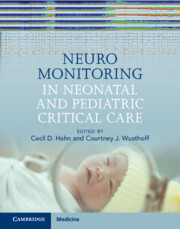Book contents
- Neuromonitoring in Neonatal and Pediatric Critical Care
- Reviews
- Neuromonitoring in Neonatal and Pediatric Critical Care
- Copyright page
- Contents
- Contributors
- Acknowledgements
- Part I General Considerations in Neuromonitoring
- Part II Practice of Neuromonitoring: Neonatal Intensive Care Unit
- Part III Practice of Neuromonitoring: Pediatric Intensive Care Unit
- Chapter 10 Management of Status Epilepticus and Recurrent Seizures
- Chapter 11 Screening for Seizures in At-Risk Pediatric Patients
- Chapter 12 Monitoring for Impending Ischemia
- Part IV Practice of Neuromonitoring: Cardiac Intensive Care Unit
- Part V Cases
- Index
- References
Chapter 10 - Management of Status Epilepticus and Recurrent Seizures
from Part III - Practice of Neuromonitoring: Pediatric Intensive Care Unit
Published online by Cambridge University Press: 08 September 2022
- Neuromonitoring in Neonatal and Pediatric Critical Care
- Reviews
- Neuromonitoring in Neonatal and Pediatric Critical Care
- Copyright page
- Contents
- Contributors
- Acknowledgements
- Part I General Considerations in Neuromonitoring
- Part II Practice of Neuromonitoring: Neonatal Intensive Care Unit
- Part III Practice of Neuromonitoring: Pediatric Intensive Care Unit
- Chapter 10 Management of Status Epilepticus and Recurrent Seizures
- Chapter 11 Screening for Seizures in At-Risk Pediatric Patients
- Chapter 12 Monitoring for Impending Ischemia
- Part IV Practice of Neuromonitoring: Cardiac Intensive Care Unit
- Part V Cases
- Index
- References
Summary
Status epilepticus is a life-threatening and time-sensitive emergency. Continuous EEG monitoring allows the detection of electrographic seizures and electrographic status epilepticus. Increasing evidence guides best practices for which patients to monitor for these conditions and appropriate duration of monitoring. The treatment of SE consists of benzodiazepines, non-benzodiazepines, antiepileptic drugs, and continuous infusions; cEEG monitoring is helpful in assessing the response to treatment. Interpretation of EEG after electrographic seizures requires care, as some patterns on the ictal-interictal continuum may be challenging. This chapter reviews current evidence regarding neuromonitoring and the management of status epilepticus and recurrent seizures.
Keywords
- Type
- Chapter
- Information
- Neuromonitoring in Neonatal and Pediatric Critical Care , pp. 137 - 148Publisher: Cambridge University PressPrint publication year: 2022



